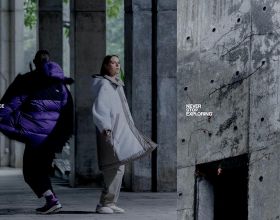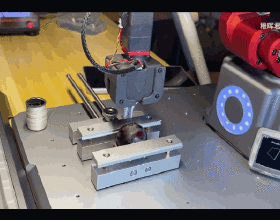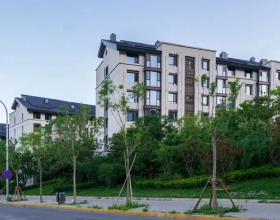環境誘導的表型被認為是啟動適應性進化並使其偏向特定方向。發生這種情況的可能性部分取決於可塑性反應與性狀的加性遺傳方差和協方差的匹配程度。
透過Meta-analysis,研究者證明了對新環境的可塑性反應往往沿著表型維度發生,這些維度包含大量的加性遺傳變異。該結論表明環境誘導表型是有效的。
Alternative scenarios describing differences in the short-term evolutionary potential of environmentally induced phenotypes. Ellipses depict multivariate phenotypic (P, light color) and genotypic (G, dark color) variation for two traits (Trait 1 and Trait 2). Arrows connecting the centroids of nonnovel (green) and novel (orange) environments are the plasticity vectors that describe the change in multivariate mean phenotype (P) between two environments. (A) Plastic responses to novel environments can be said to have high evolutionary potential if there is ample genetic variation underlying P and the vector of plastic response is well-aligned with the major axis of genetic variation in the novel environment (i.e., dark orange ellipse). (B) Plastic phenotypic responses can be said to have low evolutionary potential if there is limited genetic variation underlying P and the vector of plastic response does not align with the major axis of genetic variation in the novel environment.
新環境下加性遺傳變異的變化:
研究者首先探索了新環境條件是否會透過產生效應大小來對比非新環境和新環境中G的結構,從而導致加性遺傳變異(即“隱性遺傳變異”)的增加。
結果表明:新環境是否有脅迫並不影響加性遺傳變異的變化。
Mean effect sizes comparing the change in genetic variation across environments for studies where novel environmental manipulations were stressful (Stressful/Nonstressful) and with different breeding designs (Half-sib vs. Full-sib). (A) Total SDV between G matrices across environments. (B) Change in the proportion of variation along gmax(PVmax) between G matrices across environments. Note that in all cases effect sizes are means for a study for an average number of traits and are independent of other factors (i.e., marginalized means) in the model (see Materials and Methods).
評估環境誘導表型的短期進化潛力:
環境誘導表型偏向進化分化的可能性取決於可塑性反應沿著具有遺傳變異的表型維度下降的程度。
在非新環境和新環境下,可塑性載體的性狀均存在顯著的加性遺傳方差(非新環境和新環境中的平均變異分別為69.14%和71.06%)。
Mean effect sizes comparing plastic responses to G in nonnovel and novel environments (Nonnovel vs. Novel) and using different breeding designs (Half-sib vs. Full-sib). (A) Proportion of genetic variation along the plastic response vector ðπeÞ. (B) The alignment between the plastic response vector and main axes of genetic variation gmaxðθeÞ. Negative values indicate that the plastic response vector and gmaxis fully aligned (i.e., ∼0°), whereas positive values indicate that the plastic response vector and gmaxis not aligned (i.e., ∼90°). Values of 0 indicate that the plastic response vector and gmaxare 45° to one another. Note that in all cases effect sizes are means for a study for an average number of traits and are independent of other factors (i.e., marginalized means) in the model (Materials and Methods).
綜上所述,可塑性方向與加性遺傳變異主軸之間的一致性解釋是:發育系統傾向於對新環境作出反應(如同對基因突變作出反應)。使得區分進化方向是否受可塑性或遺傳“約束”的影響具有挑戰性,因此,研究結果強調需要新的理論和經驗方法來解決可塑性在進化中的作用。
(A–D) Examples of the different effect size measures describing changes in G and P within and across nonnovel (green-“NN”) and novel (orange-“Nov”) environments. While both G and P were compared to each other, and themselves, within and across environments, we present effect sizes comparing G matrices only for simplicity. See text for more details. (E) Schematic example of the Monte Carlo simulations used to generate effect sizes and corresponding sampling variance described in A–D.
理論表明,種群可以透過對環境誘導反應的基因改造而進化。本研究證明,這種對新環境的可塑性反應傾向於沿著具有高度遺傳變異的性狀維度發生,這表明對環境誘導表型的選擇通常是有效的。生物體對環境新穎性和基因變異的反應方式類似(透過發育的內在聯絡來解釋)。因此,區分可塑性或遺傳約束是否會影響環境變化後的進化反應具有挑戰性。
來源:http://www.pnas.org/cgi/doi/10.1073/pnas.1821066116
本文來自公眾號“農業之巔”,“農業之巔”是由南京智農雲芯大資料科技有限公司(AgriBrain)運營的學術公眾號,聚焦於智慧農業領域的最新前沿成果。南京智農雲芯大資料科技有限公司是一家專注農業領域大資料分析與人工智慧解決方案的高科技公司,基於自主研發的無程式碼AI平臺GrowthBrain、自動化表型引擎PhenoBrain和高精度全基因組選擇演算法平臺GSP,旨在為科研、教育和企業使用者提供低成本、高效率、智慧化的AI解決方案。













